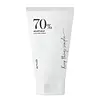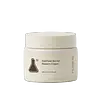What's inside
What's inside
 Key Ingredients
Key Ingredients

 Benefits
Benefits

 Concerns
Concerns

No concerns
 Ingredients Side-by-side
Ingredients Side-by-side

Houttuynia Cordata Extract 70%
Skin ConditioningButylene Glycol
HumectantGlycerin
HumectantIsoamyl Laurate
EmollientWater
Skin ConditioningPentylene Glycol
Skin Conditioning1,2-Hexanediol
Skin ConditioningCentella Asiatica Extract
CleansingPortulaca Oleracea Extract
Skin ConditioningBetaine
HumectantMadecassic Acid
Skin ConditioningAsiatic Acid
Skin ConditioningAsiaticoside
AntioxidantChlorella Vulgaris Extract
Skin ConditioningPanthenol
Skin ConditioningEthylhexylglycerin
Skin ConditioningHydrogenated Polydecene
EmollientGlucose
HumectantNiacinamide
SmoothingVinyldimethicone
Caprylyl Methicone
Skin ConditioningHydroxyethyl Acrylate/Sodium Acryloyldimethyl Taurate Copolymer
Emulsion StabilisingAcrylates/C10-30 Alkyl Acrylate Crosspolymer
Emulsion StabilisingDimethiconol
EmollientPolymethylsilsesquioxane
Glyceryl Acrylate/Acrylic Acid Copolymer
HumectantTromethamine
BufferingAmmonium Acryloyldimethyltaurate/Vp Copolymer
Fructooligosaccharides
HumectantFructose
HumectantDipotassium Glycyrrhizate
HumectantSodium Phytate
Dipropylene Glycol
HumectantTocopherol
AntioxidantXanthan Gum
EmulsifyingHouttuynia Cordata Extract 70%, Butylene Glycol, Glycerin, Isoamyl Laurate, Water, Pentylene Glycol, 1,2-Hexanediol, Centella Asiatica Extract, Portulaca Oleracea Extract, Betaine, Madecassic Acid, Asiatic Acid, Asiaticoside, Chlorella Vulgaris Extract, Panthenol, Ethylhexylglycerin, Hydrogenated Polydecene, Glucose, Niacinamide, Vinyldimethicone, Caprylyl Methicone, Hydroxyethyl Acrylate/Sodium Acryloyldimethyl Taurate Copolymer, Acrylates/C10-30 Alkyl Acrylate Crosspolymer, Dimethiconol, Polymethylsilsesquioxane, Glyceryl Acrylate/Acrylic Acid Copolymer, Tromethamine, Ammonium Acryloyldimethyltaurate/Vp Copolymer, Fructooligosaccharides, Fructose, Dipotassium Glycyrrhizate, Sodium Phytate, Dipropylene Glycol, Tocopherol, Xanthan Gum
Avena Sativa Protein Extract
Skin ConditioningDimethicone
EmollientGlycerin
HumectantSqualane
EmollientHydrogenated Polydecene
Emollient1,2-Hexanediol
Skin ConditioningCetyl PEG/PPG-10/1 Dimethicone
EmulsifyingButylene Glycol
HumectantPropanediol
SolventButyrospermum Parkii Butter
Skin ConditioningTapioca Starch
Avena Sativa Kernel Protein
Skin ConditioningSimmondsia Chinensis Seed Oil
EmollientTheobroma Cacao Extract
Skin ConditioningMacadamia Integrifolia Seed Oil
Skin ConditioningOat Amino Acids
Skin ConditioningBifida Ferment Lysate
Skin ConditioningPanthenol
Skin ConditioningMagnesium Sulfate
Water
Skin ConditioningCaprylyl Glycol
EmollientCyclopentasiloxane
EmollientEthylhexylglycerin
Skin ConditioningPentylene Glycol
Skin ConditioningLauryl Polyglyceryl-3 Polydimethylsiloxyethyl Dimethicone
Skin ConditioningTrisodium Ethylenediamine Disuccinate
Beta-Sitosterol
Emulsion StabilisingAluminum Hydroxide
EmollientPolyglyceryl-10 Stearate
Skin ConditioningTriethoxycaprylylsilane
Dextrin
AbsorbentHydrogenated Lecithin
EmulsifyingPolyhydroxystearic Acid
EmulsifyingAluminum Sucrose Octasulfate
Skin ConditioningBrassica Campestris Sterols
EmollientCholesterol
EmollientHydroxyphenyl Propamidobenzoic Acid
Skin ConditioningPhytosteryl/Behenyl/Octyldodecyl Lauroyl Glutamate
Skin ConditioningPolyglyceryl-10 Oleate
Skin ConditioningNeopentyl Glycol Diethylhexanoate
EmollientSodium Surfactin
CleansingCellulose
AbsorbentPentaerythrityl Tetra-Di-T-Butyl Hydroxyhydrocinnamate
AntioxidantTriisopropanolamine
BufferingAscorbyl Palmitate
AntioxidantTocopherol
AntioxidantDisodium EDTA
Titanium Dioxide
Cosmetic ColorantAvena Sativa Protein Extract, Dimethicone, Glycerin, Squalane, Hydrogenated Polydecene, 1,2-Hexanediol, Cetyl PEG/PPG-10/1 Dimethicone, Butylene Glycol, Propanediol, Butyrospermum Parkii Butter, Tapioca Starch, Avena Sativa Kernel Protein, Simmondsia Chinensis Seed Oil, Theobroma Cacao Extract, Macadamia Integrifolia Seed Oil, Oat Amino Acids, Bifida Ferment Lysate, Panthenol, Magnesium Sulfate, Water, Caprylyl Glycol, Cyclopentasiloxane, Ethylhexylglycerin, Pentylene Glycol, Lauryl Polyglyceryl-3 Polydimethylsiloxyethyl Dimethicone, Trisodium Ethylenediamine Disuccinate, Beta-Sitosterol, Aluminum Hydroxide, Polyglyceryl-10 Stearate, Triethoxycaprylylsilane, Dextrin, Hydrogenated Lecithin, Polyhydroxystearic Acid, Aluminum Sucrose Octasulfate, Brassica Campestris Sterols, Cholesterol, Hydroxyphenyl Propamidobenzoic Acid, Phytosteryl/Behenyl/Octyldodecyl Lauroyl Glutamate, Polyglyceryl-10 Oleate, Neopentyl Glycol Diethylhexanoate, Sodium Surfactin, Cellulose, Pentaerythrityl Tetra-Di-T-Butyl Hydroxyhydrocinnamate, Triisopropanolamine, Ascorbyl Palmitate, Tocopherol, Disodium EDTA, Titanium Dioxide
 Reviews
Reviews

Ingredients Explained
These ingredients are found in both products.
Ingredients higher up in an ingredient list are typically present in a larger amount.
1,2-Hexanediol is a synthetic liquid and another multi-functional powerhouse.
It is a:
- Humectant, drawing moisture into the skin
- Emollient, helping to soften skin
- Solvent, dispersing and stabilizing formulas
- Preservative booster, enhancing the antimicrobial activity of other preservatives
Butylene Glycol (or BG) is used within cosmetic products for a few different reasons:
Overall, Butylene Glycol is a safe and well-rounded ingredient that works well with other ingredients.
Though this ingredient works well with most skin types, some people with sensitive skin may experience a reaction such as allergic rashes, closed comedones, or itchiness.
Learn more about Butylene GlycolEthylhexylglycerin (we can't pronounce this either) is commonly used as a preservative and skin softener. It is derived from glyceryl.
You might see Ethylhexylglycerin often paired with other preservatives such as phenoxyethanol. Ethylhexylglycerin has been found to increase the effectiveness of these other preservatives.
Glycerin is already naturally found in your skin. It helps moisturize and protect your skin.
A study from 2016 found glycerin to be more effective as a humectant than AHAs and hyaluronic acid.
As a humectant, it helps the skin stay hydrated by pulling moisture to your skin. The low molecular weight of glycerin allows it to pull moisture into the deeper layers of your skin.
Hydrated skin improves your skin barrier; Your skin barrier helps protect against irritants and bacteria.
Glycerin has also been found to have antimicrobial and antiviral properties. Due to these properties, glycerin is often used in wound and burn treatments.
In cosmetics, glycerin is usually derived from plants such as soybean or palm. However, it can also be sourced from animals, such as tallow or animal fat.
This ingredient is organic, colorless, odorless, and non-toxic.
Glycerin is the name for this ingredient in American English. British English uses Glycerol/Glycerine.
Learn more about GlycerinHydrogenated Polydecene is an emollient. It creates a non-occlusive film on the skin that offers extra protection for your skin barrier.
The texture of Hydrogenated Polydecene ranges from light and silky to rich.
Hydrogenated Polydecene is the end compound of controlled hydrogenation of Polydecene.
Learn more about Hydrogenated PolydecenePanthenol is a common ingredient that helps hydrate and soothe the skin. It is found naturally in our skin and hair.
There are two forms of panthenol: D and L.
D-panthenol is also known as dexpanthenol. Most cosmetics use dexpanthenol or a mixture of D and L-panthenol.
Panthenol is famous due to its ability to go deeper into the skin's layers. Using this ingredient has numerous pros (and no cons):
Like hyaluronic acid, panthenol is a humectant. Humectants are able to bind and hold large amounts of water to keep skin hydrated.
This ingredient works well for wound healing. It works by increasing tissue in the wound and helps close open wounds.
Once oxidized, panthenol converts to pantothenic acid. Panthothenic acid is found in all living cells.
This ingredient is also referred to as pro-vitamin B5.
Learn more about PanthenolPentylene glycol is typically used within a product to thicken it. It also adds a smooth, soft, and moisturizing feel to the product. It is naturally found in plants such as sugar beets.
The hydrophilic trait of Pentylene Glycol makes it a humectant. As a humectant, Pentylene Glycol helps draw moisture from the air to your skin. This can help keep your skin hydrated.
This property also makes Pentylene Glycol a great texture enhancer. It can also help thicken or stabilize a product.
Pentylene Glycol also acts as a mild preservative and helps to keep a product microbe-free.
Some people may experience mild eye and skin irritation from Pentylene Glycol. We always recommend speaking with a professional about using this ingredient in your routine.
Pentylene Glycol has a low molecular weight and is part of the 1,2-glycol family.
Learn more about Pentylene GlycolTocopherol (also known as Vitamin E) is a common antioxidant used to help protect the skin from free-radicals and strengthen the skin barrier. It's also fat soluble - this means our skin is great at absorbing it.
Vitamin E also helps keep your natural skin lipids healthy. Your lipid skin barrier naturally consists of lipids, ceramides, and fatty acids. Vitamin E offers extra protection for your skin’s lipid barrier, keeping your skin healthy and nourished.
Another benefit is a bit of UV protection. Vitamin E helps reduce the damage caused by UVB rays. (It should not replace your sunscreen). Combining it with Vitamin C can decrease sunburned cells and hyperpigmentation after UV exposure.
You might have noticed Vitamin E + C often paired together. This is because it is great at stabilizing Vitamin C. Using the two together helps increase the effectiveness of both ingredients.
There are often claims that Vitamin E can reduce/prevent scarring, but these claims haven't been confirmed by scientific research.
Learn more about TocopherolWater. It's the most common cosmetic ingredient of all. You'll usually see it at the top of ingredient lists, meaning that it makes up the largest part of the product.
So why is it so popular? Water most often acts as a solvent - this means that it helps dissolve other ingredients into the formulation.
You'll also recognize water as that liquid we all need to stay alive. If you see this, drink a glass of water. Stay hydrated!
Learn more about Water